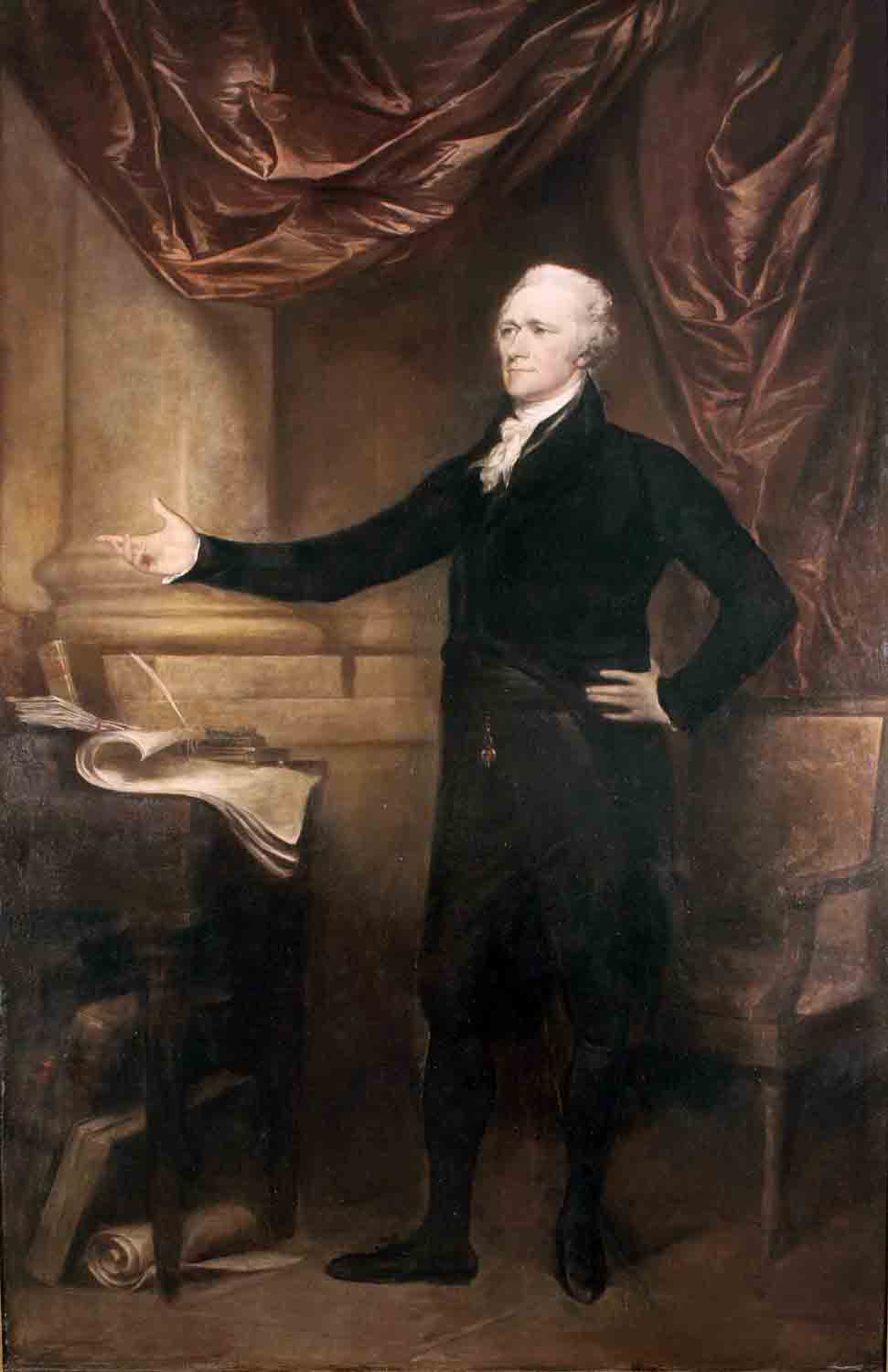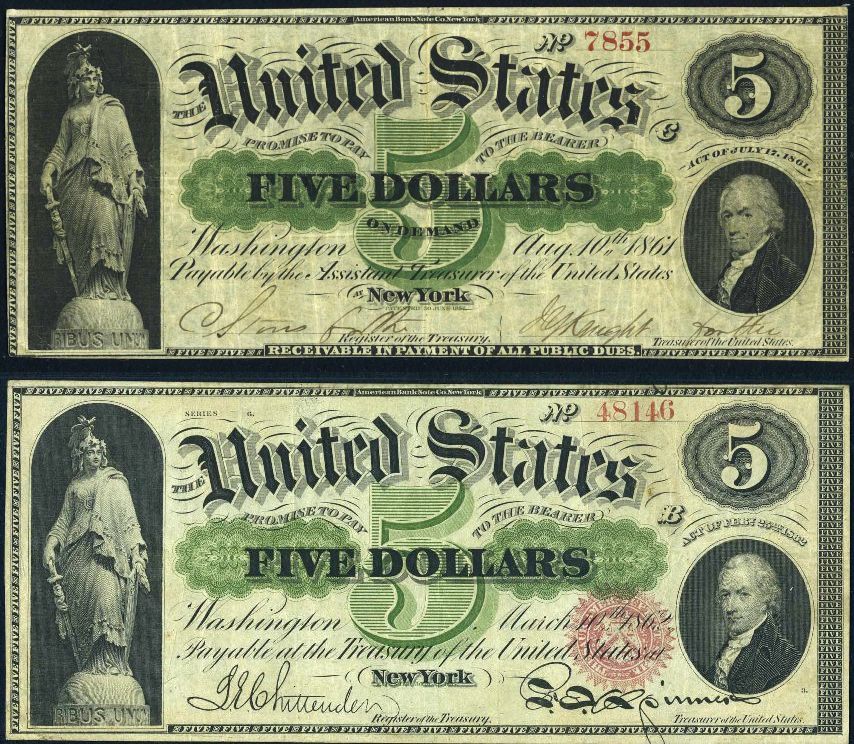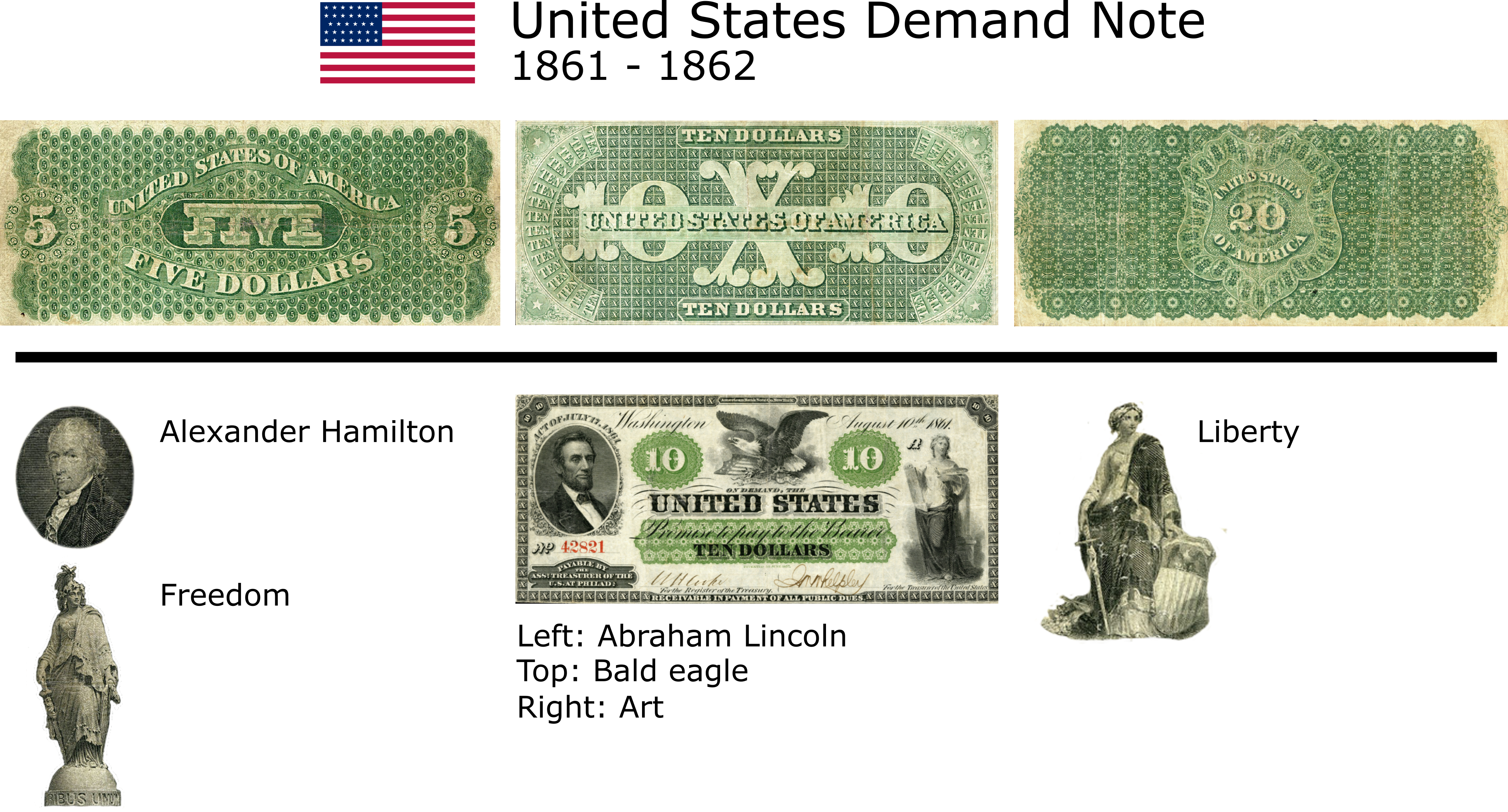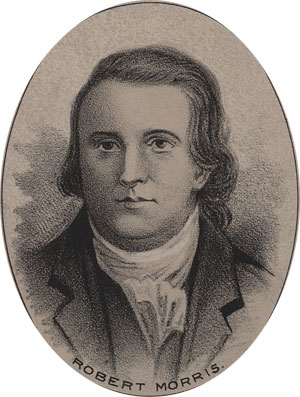|
United States Ten-dollar Bill
The United States ten-dollar bill ($10) is a Denomination (currency), denomination of U.S. currency. The obverse of the bill features the portrait of Alexander Hamilton, who served as the first U.S. Secretary of the Treasury. The Obverse and reverse, reverse features the U.S. Treasury Building. All $10 bills issued today are Federal Reserve Notes. As of December 2018, the average life of a $10 bill in Circulation (currency), circulation is 5.3 years before it is replaced due to wear. Ten-dollar bills are delivered by Federal Reserve Banks in yellow straps. The source of the portrait on the $10 bill is John Trumbull's 1805 painting of Hamilton that belongs to the portrait collection of New York City Hall. The $10 bill is unique in that it is the only denomination in circulation in which the portrait faces to the left. It also features one of two non-presidents on currently issued U.S. bills, the other being Benjamin Franklin on the United States one hundred-dollar bill, $100 bill. ... [...More Info...] [...Related Items...] OR: [Wikipedia] [Google] [Baidu] |
United States Dollar
The United States dollar ( symbol: $; code: USD; also abbreviated US$ or U.S. Dollar, to distinguish it from other dollar-denominated currencies; referred to as the dollar, U.S. dollar, American dollar, or colloquially buck) is the official currency of the United States and several other countries. The Coinage Act of 1792 introduced the U.S. dollar at par with the Spanish silver dollar, divided it into 100 cents, and authorized the minting of coins denominated in dollars and cents. U.S. banknotes are issued in the form of Federal Reserve Notes, popularly called greenbacks due to their predominantly green color. The monetary policy of the United States is conducted by the Federal Reserve System, which acts as the nation's central bank. The U.S. dollar was originally defined under a bimetallic standard of (0.7735 troy ounces) fine silver or, from 1837, fine gold, or $20.67 per troy ounce. The Gold Standard Act of 1900 linked the dollar solely to gold. From 1934, it ... [...More Info...] [...Related Items...] OR: [Wikipedia] [Google] [Baidu] |
Benjamin Franklin
Benjamin Franklin ( April 17, 1790) was an American polymath who was active as a writer, scientist, inventor, statesman, diplomat, printer, publisher, and political philosopher. Encyclopædia Britannica, Wood, 2021 Among the leading intellectuals of his time, Franklin was one of the Founding Fathers of the United States, a drafter and signer of the United States Declaration of Independence, and the first United States Postmaster General. As a scientist, he was a major figure in the American Enlightenment and the history of physics for his studies of electricity, and for charting and naming the current still known as the Gulf Stream. As an inventor, he is known for the lightning rod, bifocals, and the Franklin stove, among others. He founded many civic organizations, including the Library Company, Philadelphia's first fire department, and the University of Pennsylvania. Isaacson, 2004, p. Franklin earned the title of "The First American" for his early and indefa ... [...More Info...] [...Related Items...] OR: [Wikipedia] [Google] [Baidu] |
Sawbuck
In woodworking, a sawbuck is a structure for holding wood so that it may be cut into pieces. Easily made in the field from rough material, it consists of an "X" form at each end which are joined by cross bars below the intersections of the X's. The wood to be cut is placed in the V's formed above the intersections of the X's. A sawbuck is very simple to build. The five "V" sawbuck was designed with 10 vertical 2×4s, and four horizontal, 2×6s, secured with wood screws. It was designed this way in order to cut two or more smaller pieces ( in length) of firewood in rapid succession. A sawbuck should be heavy enough to negate any kickback from the saw while cutting. Building a sawbuck that is too light could result in injury as it may tip over while cutting, especially with a chainsaw. In Canada and Britain, and the United States, a sawbuck is called a ''sawhorse'' or a sawstool, although this term also refers to a similar device used (often in pairs) to support wood planks. ... [...More Info...] [...Related Items...] OR: [Wikipedia] [Google] [Baidu] |
United States Note
A United States Note, also known as a Legal Tender Note, is a type of paper money that was issued from 1862 to 1971 in the U.S. Having been current for 109 years, they were issued for longer than any other form of U.S. paper money. They were known popularly as "greenbacks", a name inherited from the earlier greenbacks, the Demand Notes, that they replaced in 1862. Often termed Legal Tender Notes, they were named United States Notes by the First Legal Tender Act, which authorized them as a form of fiat currency. During the early 1860s the so-called ''second obligation'' on the reverse of the notes stated: By the 1930s, this obligation would eventually be shortened to: They were originally issued directly into circulation by the U.S. Treasury to pay expenses incurred by the Union during the American Civil War. During the next century, the legislation governing these notes was modified many times and numerous versions were issued by the Treasury. United States Notes that w ... [...More Info...] [...Related Items...] OR: [Wikipedia] [Google] [Baidu] |
Allegorical
As a literary device or artistic form, an allegory is a narrative or visual representation in which a character, place, or event can be interpreted to represent a hidden meaning with moral or political significance. Authors have used allegory throughout history in all forms of art to illustrate or convey complex ideas and concepts in ways that are comprehensible or striking to its viewers, readers, or listeners. Writers and speakers typically use allegories to convey (semi-)hidden or complex meanings through symbolic figures, actions, imagery, or events, which together create the moral, spiritual, or political meaning the author wishes to convey. Many allegories use personification of abstract concepts. Etymology First attested in English in 1382, the word ''allegory'' comes from Latin ''allegoria'', the latinisation of the Greek ἀλληγορία (''allegoría''), "veiled language, figurative", which in turn comes from both ἄλλος (''allos''), "another, different" ... [...More Info...] [...Related Items...] OR: [Wikipedia] [Google] [Baidu] |
Abraham Lincoln
Abraham Lincoln ( ; February 12, 1809 – April 15, 1865) was an American lawyer, politician, and statesman who served as the 16th president of the United States from 1861 until his assassination in 1865. Lincoln led the nation through the American Civil War and succeeded in preserving the Union, abolishing slavery, bolstering the federal government, and modernizing the U.S. economy. Lincoln was born into poverty in a log cabin in Kentucky and was raised on the frontier, primarily in Indiana. He was self-educated and became a lawyer, Whig Party leader, Illinois state legislator, and U.S. Congressman from Illinois. In 1849, he returned to his successful law practice in central Illinois. In 1854, he was angered by the Kansas–Nebraska Act, which opened the territories to slavery, and he re-entered politics. He soon became a leader of the new Republican Party. He reached a national audience in the 1858 Senate campaign debates against Stephen A. Douglas. ... [...More Info...] [...Related Items...] OR: [Wikipedia] [Google] [Baidu] |
Demand Note
A Demand Note is a type of United States paper money that was issued between August 1861 and April 1862 during the American Civil War in denominations of 5, 10, and 20 . Demand Notes were the first issue of paper money by the United States that achieved wide circulation and they are still in circulation today, though they are now extremely rare. The U.S. government placed the Demand Notes into circulation by using them to pay expenses incurred during the Civil War including the salaries of its workers and military personnel. Because of the distinctive green ink on their reverse, and because state-chartered bank and Confederate notes of the day typically had blank reverse, the Demand Notes were nicknamed "greenbacks", a name later inherited by United States Notes and Federal Reserve Notes. The obverse of the Demand Notes contained familiar elements such as the images of a bald eagle, Abraham Lincoln, and Alexander Hamilton, though the portraits used on Demand Notes are diffe ... [...More Info...] [...Related Items...] OR: [Wikipedia] [Google] [Baidu] |
Hamilton Trumbull - 1805
Hamilton may refer to: People * Hamilton (name), a common British surname and occasional given name, usually of Scottish origin, including a list of persons with the surname ** The Duke of Hamilton, the premier peer of Scotland ** Lord Hamilton (other), several Scottish, Irish and British peers, and some members of the judiciary, who may be referred to simply as ''Hamilton'' ** Clan Hamilton, an ancient Scottish kindred * Alexander Hamilton (1755–1804), first U.S. Secretary of the Treasury and one of the Founding Fathers of the United States * Lewis Hamilton, a British Formula One driver *William Rowan Hamilton (1805–1865), Irish physicist, astronomer, and mathematician for whom ''Hamiltonian mechanics'' is named * Hamílton (footballer) (born 1980), Togolese footballer Places Australia * Hamilton, New South Wales, suburb of Newcastle * Hamilton Hill, Western Australia, suburb of Perth * Hamilton, South Australia * Hamilton, Tasmania * Hamilton, Victoria Qu ... [...More Info...] [...Related Items...] OR: [Wikipedia] [Google] [Baidu] |
Robert Morris (financier)
Robert Morris Jr. (January 20, 1734May 8, 1806) was an English-born merchant and a Founding Father of the United States. He served as a member of the Pennsylvania legislature, the Second Continental Congress, and the United States Senate, and he was a signer of the Declaration of Independence, the Articles of Confederation, and the United States Constitution. From 1781 to 1784, he served as the Superintendent of Finance of the United States, becoming known as the "Financier of the Revolution." Along with Alexander Hamilton and Albert Gallatin, he is widely regarded as one of the founders of the financial system of the United States. Born in Liverpool, Morris migrated to North America in his teens, quickly becoming a partner in a successful shipping firm based in Philadelphia. In the aftermath of the French and Indian War, Morris joined with other merchants in opposing British tax policies such as the 1765 Stamp Act. By 1775 he was the richest man in America. After the outbreak ... [...More Info...] [...Related Items...] OR: [Wikipedia] [Google] [Baidu] |
George Meade
George Gordon Meade (December 31, 1815 – November 6, 1872) was a United States Army officer and civil engineer best known for decisively defeating Confederate States Army, Confederate Full General (CSA), General Robert E. Lee at the Battle of Gettysburg in the American Civil War. He previously fought with distinction in the Second Seminole War and the Mexican–American War. During the Civil War, he served as a Union Army, Union General officer, general, rising from command of a brigade to that of the Army of the Potomac. Earlier in his career, he was an engineer and was involved in the coastal construction of several lighthouses. Meade's Civil War combat experience started as a brigade commander (brigadier general) in the Peninsula Campaign and the Seven Days Battles. He was severely wounded while leading his brigade at the Battle of Glendale. As a division commander, he had notable success at the Battle of South Mountain and assumed temporary corps command at the Battle o ... [...More Info...] [...Related Items...] OR: [Wikipedia] [Google] [Baidu] |








